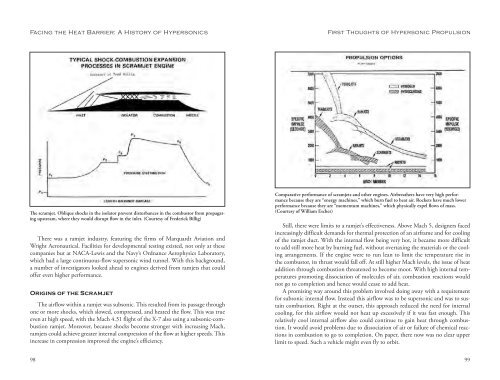Facing the Heat Barrier - NASA's History Office
Facing the Heat Barrier - NASA's History Office
Facing the Heat Barrier - NASA's History Office
You also want an ePaper? Increase the reach of your titles
YUMPU automatically turns print PDFs into web optimized ePapers that Google loves.
<strong>Facing</strong> <strong>the</strong> <strong>Heat</strong> <strong>Barrier</strong>: A <strong>History</strong> of Hypersonics<br />
The scramjet. Oblique shocks in <strong>the</strong> isolator prevent disturbances in <strong>the</strong> combustor from propagating<br />
upstream, where <strong>the</strong>y would disrupt flow in <strong>the</strong> inlet. (Courtesy of Frederick Billig)<br />
There was a ramjet industry, featuring <strong>the</strong> firms of Marquardt Aviation and<br />
Wright Aeronautical. Facilities for developmental testing existed, not only at <strong>the</strong>se<br />
companies but at NACA-Lewis and <strong>the</strong> Navy’s Ordnance Aerophysics Laboratory,<br />
which had a large continuous-flow supersonic wind tunnel. With this background,<br />
a number of investigators looked ahead to engines derived from ramjets that could<br />
offer even higher performance.<br />
Origins of <strong>the</strong> Scramjet<br />
The airflow within a ramjet was subsonic. This resulted from its passage through<br />
one or more shocks, which slowed, compressed, and heated <strong>the</strong> flow. This was true<br />
even at high speed, with <strong>the</strong> Mach 4.31 flight of <strong>the</strong> X-7 also using a subsonic-combustion<br />
ramjet. Moreover, because shocks become stronger with increasing Mach,<br />
ramjets could achieve greater internal compression of <strong>the</strong> flow at higher speeds. This<br />
increase in compression improved <strong>the</strong> engine’s efficiency.<br />
98<br />
First Thoughts of Hypersonic Propulsion<br />
Comparative performance of scramjets and o<strong>the</strong>r engines. Airbrea<strong>the</strong>rs have very high performance<br />
because <strong>the</strong>y are “energy machines,” which burn fuel to heat air. Rockets have much lower<br />
performance because <strong>the</strong>y are “momentum machines,” which physically expel flows of mass.<br />
(Courtesy of William Escher)<br />
Still, <strong>the</strong>re were limits to a ramjet’s effectiveness. Above Mach 5, designers faced<br />
increasingly difficult demands for <strong>the</strong>rmal protection of an airframe and for cooling<br />
of <strong>the</strong> ramjet duct. With <strong>the</strong> internal flow being very hot, it became more difficult<br />
to add still more heat by burning fuel, without overtaxing <strong>the</strong> materials or <strong>the</strong> cooling<br />
arrangements. If <strong>the</strong> engine were to run lean to limit <strong>the</strong> temperature rise in<br />
<strong>the</strong> combustor, its thrust would fall off. At still higher Mach levels, <strong>the</strong> issue of heat<br />
addition through combustion threatened to become moot. With high internal temperatures<br />
promoting dissociation of molecules of air, combustion reactions would<br />
not go to completion and hence would cease to add heat.<br />
A promising way around this problem involved doing away with a requirement<br />
for subsonic internal flow. Instead this airflow was to be supersonic and was to sustain<br />
combustion. Right at <strong>the</strong> outset, this approach reduced <strong>the</strong> need for internal<br />
cooling, for this airflow would not heat up excessively if it was fast enough. This<br />
relatively cool internal airflow also could continue to gain heat through combustion.<br />
It would avoid problems due to dissociation of air or failure of chemical reactions<br />
in combustion to go to completion. On paper, <strong>the</strong>re now was no clear upper<br />
limit to speed. Such a vehicle might even fly to orbit.<br />
99
















